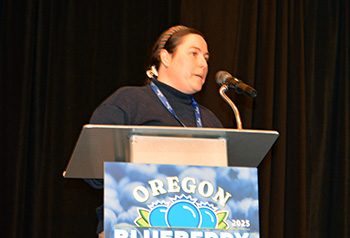Blueberry Breeder Unveils Program Priorities
USDA-Agricultural Research Service blueberry breeder Jenyne Loarca is focusing on fruit quality, machine harvestability, postharvest longevity, disease resistance, insect resistance and plant-stress tolerance in her work with the USDA-ARS and OSU Cooperative Berry Breeding Program.
Loarca, who started in September 2024 at the Corvallis-based Horticultural Crops Production and Genetic Improvement Research Unit, is basing her breeding priorities off a 2017 survey that asked blueberry growers, processors and distributors for their top issues.
 |
Jenyne Loarca at the Oregon Blueberry Conference said fruit quality, harvestability factors and pest resistance are among priorities she is focusing on in her work with the USDA-ARS and OSU Cooperative Breeding Program. |
In a presentation at the Oregon Blueberry Conference in February, Loarca noted that nearly 70 percent of respondents to the Blueberry Survey Report identified fruit quality as their top issue, and within that category, firmness, flavor and long shelf-life were identified as key traits.
A little more than 14 percent of respondents identified developing berries for machine harvest as a key trait, with uniform ripening and bruising resistance sought-after traits.
Respondents identified mummy berry as a top disease issues they would like to have addressed in the breeding program. And Spotted Wing Drosophila (SWD) was by far the biggest insect pest of concern. Frost and heat tolerances ranked as the most pressing concern in the plant-stress tolerance category.
“That is the kind of berry that I’m going for,” Loarca said. She added that she considers the list “a living document.”
“If there’s anything on here that at any point becomes obsolete, let me know. It can be updated. But if this looks good for now, this is what I am going to be focusing on for the next five to ten years,” she said.
Loarca brings classical phenotyping methods into the Cooperative Blueberry Breeding Program as well as modern high throughput phenotyping and genotyping tools.
“I’m really excited to bring it all together and see how these can complement one another, because they each have a place where they are appropriate and efficient,” she said.
Loarca plans to work closely with researchers at Oregon State University and elsewhere to advance the program’s breeding efforts. Included in this collaboration is a program called Breeding Insight, a USDA initiative to develop breeding tools for specialty crops.
“The trend in breeding has always been to give more money to corn and soybeans to do genotyping and breeding. Specialty crops are behind in terms of breeding and tools,” she said. “This initiative was put together to add support to this frankly very underfunded area of research.
“I collaborated with them a lot, and will continue to do so,” she said.
Loarca also worked closely with the Vaccinium Coordinated Agriculture Project (VacCAP) during her time in the cranberry breeding program at the University of Wisconsin, Madison, and plans to do so in her current position, as well. VacCAP is a national project that involves seventy blueberry and cranberry scientists and international research partners in plant breeding, plant genetics, cooperative extension, food science and horticulture at seven universities and three USDA-ARS sites. The project is focused on genomics and developing tools for breeders to employ marker-assisted breeding programs, she said.
Loarca also plans to utilize the National Plant Germplasm System in her work, including the gene bank in Corvallis.
““We need genetic diversity to adapt to anything that might come our way, and that diversity often gets lost in the process of breeding. The National Clonal Germplasm Repository is a recourse that blueberry breeders can leverage to identify sources of useful genetics."
|
“We need genetic diversity to adapt to anything that might come our way, and that diversity often gets lost in the process of breeding,” she said. “The National Clonal Germplasm Repository is a recourse that blueberry breeders can leverage to identify sources of useful genetics.”
Loarca is encouraging growers and processors to invite her to their operations so she and her team can gain a better understanding of the needs of the industry.
“We (she and her breeding technician Matt Scott) can only learn so much from the journals or textbooks telling us how to grow the crop,” she said. “We both feel that it is something that you really need to see.
“We want to understand everything about it,” she said. “We want to know what your problems are related to the crop. Please reach out (Jenyne.Loarca@usda.gov) if that sounds like something you could do for us.”